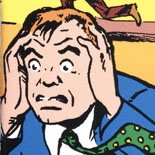The Plain Janes—It's "Mean Girls" meets "V for Vendetta"
And I'm only half joking about that. Yes, though nefarious means (i.e. someone in DC Publicity handed it to me), I obtained a galley copy of The Plain Janes, the first graphic novel from DC Comics' new imprint for teen girls, MINX.
Yes, though nefarious means (i.e. someone in DC Publicity handed it to me), I obtained a galley copy of The Plain Janes, the first graphic novel from DC Comics' new imprint for teen girls, MINX.
Personally, I think that MINX as a concept is a very good idea. Expanding the comic book reading audience to be as inclusive as possible, with as much variety of content as possible, is critical to the long term success of the medium, AND only DC Comics really has the resources and commitment to successfully back such a venture. Of course, actually attracting a new audience depends entirely on the quality of the content produced.
Fortunately, if this book is indicative of what's to come, I think they are off to a good start.
Right away, it's clear that this book is not another superhero book or even another Vertigo book, shrunk down and repackaged. And it's not American manga, either. It's its own animal.
Cecil Castellucci writes a compelling and charming story about Jane, the new girl at school, and how her crazy scheme of guerilla artwork unites the other outcasts, coincidentally also named Jane, and eventually the entire school. Though it is her first graphic novel, Castellucci is not over wordy but allows Jim Rugg's simple and expressive art do most of the storytelling. Rugg is particularly apt at drawing teen girls that actually look like teen girls, while remaining visually interesting and distinct from one another, particular the Janes.
And though the general plot is a little bit cliched, it's clear from page one that there is more going on than just high school melodrama. Layered into the story are questions about the value and purpose of art and the compromises between freedom and security we deal with in a time of terrorism (handled much better and more complexly than some other comics series I know).
Castellucci's best writing is in the narrator, "Main" Jane. Jane's struggle to find her identity in the wake of a traumatic event makes her entirely sympathetic, but she never comes across as self-pitying or morose. And though she shows a lot of maturity about the world, she remains at all times a teenager, impulsive, passionate, and sometimes overwhelmed by her emotions.
The supporting characters, however, are more two-dimensional (the other Janes, for example, refer to themselves as "BrainJayne," "TheatreJane," and "SportyJane," like Spice Girls). They remain fun and empathetic, but we never really get to know them outside of what Main Jane thinks about them.
Two characters that stand out are Jane's overprotective mother and James, "president, secretary and treasurer of the Queer Club" and the only openly gay boy in school. Jane's Mom (who's never given a real name) may be irrational in her fears and a hindrance to Jane's social life, but we know why her mother is so scared and understand that her concerns come from her love for her daughter, making Jane's Mom tragically poignant. And while I thought I was going to hate James as a token and stereotypical character, he surprised me with his bravery, honestly, and lovability. He steals every scene he's in.
My only real complaint about the book is that it kind of ends abruptly. It feels like there's a lot of story left to tell when The Plain Janes finishes, even if it does climax with a fairly strong resolution. I guess I just didn't want it to end, which isn't that bad at all.
All in all, I think The Plain Janes is a great kick off book that firmly establishes MINX as an imprint for girls looking for meaning in art, looking to improve the world, and, maybe, looking for a little bit of anarchy.
I think this could work.



4 comments:
They should be in color though. So many people are turned off by black/white comics, and Minx doing it makes me think they're trying to resemble manga. I think that to really get some respect and readership they should be in color. But I'm glad to hear that the content is decent.
*coughmangacough*
Well, yes, MINX is specifically targeting the manga reading audience, so while some people are turned off by black and white art, the specific audience they want clearly isn't.
That's pretty much where the similarity ends. The story and characters are more out of teen lit fiction (another audience MINX is actively courting), the pacing is a lot faster, and the art is closer to the independent, autobiographical style of Craig Thompson than Naruto or Fruits Basket.
You should really see someone about that cough, Kevin. I worry about you.
I read Plain Janes over the weekend and liked it. I didn't love it, but I definately liked it. I definately saw some things that I could have related to when I was younger.
I still believe that it should be in color in order to attract a larger audience. Rather than trying to reinvent Manga with American themes, which is what this feels like, I think having it be an American comic marketed to American Teen Girls would have worked better. I have found that, even including manga, color always sells better.
Post a Comment